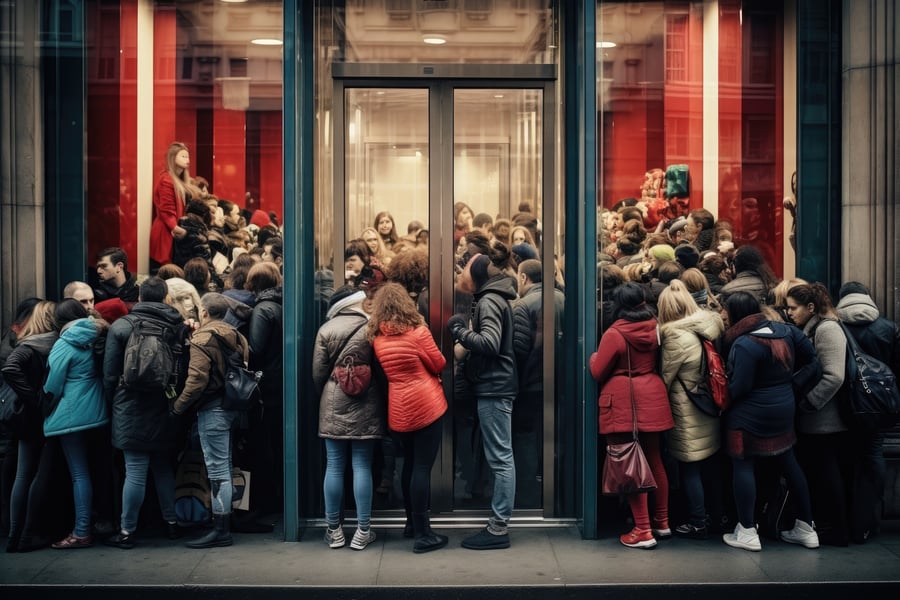Lina Chindamo is a Certified Credit Professional with over 25 years of experience in credit risk management. She has held senior leadership positions at companies like Sony Electronics, Maple Leaf Foods, and Mondelez Canada. Her extensive experience and current role, where she collaborates with c-suite partners and credit teams across various industries, make her a respected figure in the credit industry.
2023 has been a challenging year for businesses of all shapes and sizes.
From recession and inflation to an ongoing labor shortage across the U.S., companies have had to adapt quickly. Another major struggle has been the increase in bankruptcies across multiple industries.
Our data shows the increase in bankruptcies was prevalent throughout the first half of 2023 in the following sectors:
- Electric, gas and sanitary services rose by 70.21% in H1 2022.
- Retail bankruptcies jumped up 64.75% compared to the first half of 2022.
- Bankruptcies in the professional services sector increased by 44.93%.

So, the big question is: Can the 2023 holiday shopping season save retailers from bankruptcy? According to the CNBC Supply Chain Survey:
- Two-thirds of respondents expect consumers to be looking for discounts during peak retail season.
- Middle price-point items, such as jackets, are dominating early holiday order activity, while less than 20% are high-end items.
- More than half of orders will be promotional products, including free gifts with purchase.
Based on the CNBC survey’s findings, it’s predicted that retailers will be ordering less inventory and are expecting consumers to be on the lookout for discounts and freebies. And we can’t forget that last summer, big-box retailers Target and Walmart surprised the market when they revealed huge inventory builds that led to a period of steep markdowns. Those steep markdowns likely had a negative impact on annual sales and cash flow.
Get the full story on your customers and suppliers
When holiday sales miss the mark for retailers
In 2022, Walmart and Target both had poor holiday sales performance. In October 2022, year-over-year visits to Target stores were down by 2.1%. For Walmart, that number was down by 3.5% for the same period.
But not everything is set in stone. Target managed to exceed expectations by reporting fourth-quarter earnings of $31.4 billion vs. the $30.46 billion expected.
Elsewhere, other brands didn’t do as well. Department store giant Kohl’s fourth quarter revenue dropped by 7.2% year-on-year, while Nordstrom didn’t hit revenue expectations. The retailer was predicted to generate $4.34 billion in annual revenue. But it fell slightly short of those expectations -reaching $4.32 billion, which was a 4.1% year-over-year decline.
Other brands fared better during the 2022 holiday season. Abercrombie & Fitch, for example, recorded strong financial results with $1.2 billion, an increase of 3% from the previous quarter. This was driven largely by the company using TikTok to reintroduce and transform the brand for Gen Z, promoting inclusivity.
Another company that had optimistic expectations was American Eagle Outfitters (AEO). While total net revenue dropped 2.4% to $1.24 billion in 2022, better inventory and supply chain management led to greater resilience.
This was reported by AEO’s CEO Jay Schottenstain, who said: “I’m pleased to deliver a third quarter that exceeded our expectations, with profit margins meaningfully improved from the first half of the year. Bold actions to rationalize inventory and reduce expenses are paying off. Our inventory is in good shape. We are staying disciplined and focused on improving profitability and cash flow, while maintaining a healthy balance sheet. As we navigate the current macro environment, we remain focused on our strategic initiatives — leading with innovation and judiciously investing in capabilities that will differentiate us in the long run.”

What can retailers do in 2023?
Offer price matching and adjustments
Retailers need to be offering price adjustments so shoppers know they’re going to get the best possible deal. This will achieve a few things. First, it’s going to encourage people to buy now rather than later. Plus, it’ll increase footfall in stores. With customers being more likely to make a purchase, you’ll drive up sales volume and clear an overflowing inventory. Second, you can increase customer satisfaction. You’ll stand out from retailers who aren’t doing price adjustments and customers may return to buy more than once from you.
Target does a great job of price matching and adjustments to clear more inventory. The key takeaway is that it’s important to set out clear guidelines so customers know what to expect. In Target’s case, price adjustments only work under these circumstances:
- The product has been bought from Target in the past 14 days.
- An identical item, brand name, size, color, weight, quantity and model number are registered.
- A product is stocked at a lower price from a specific list of competitors.

Focus on budget-friendly deals
Rising inflation demotivated shoppers to invest in certain experiences in 2022, such as holiday celebrations and gifts. To address this, retailers should offer budget-friendly deals on specific categories that are more in tune with customer behavior in Q3 2023.
One example is alcohol. Food and beverage products historically tend to be made closer to the holidays because of the association with celebrating, eating and drinking. But offering a budget-friendly deal in December on a travel experience may be less likely to work. This is because most travellers have already made a booking by mid-December and the money has been spent.
According to Isaac Gerber, data and analytics lead at Captify, “We’re seeing early indications of a strong holiday shopping season. Interest in holiday deals is already starting to build, with mid-year interest already 450% higher than the same time last year. While many things can happen in the next few months, we’re optimistic about this return to normal for retailers who count on a boost to sales during the holiday season.”
So, to make the most of this optimism around holiday deals and budgets, it’s important to shape your marketing messaging in the right way. Emphasize that you understand how tough it’s been for shoppers needing to tighten their belts and the factors that have impacted them. Direct them towards deals that speak to them on a personal level and their circumstances.
Order inventory early
Preparing to order inventory as soon as possible means you won’t be left with unforeseen shortages for in-demand products. This means you’ll want to be thorough with all your suppliers and check their financial history. Just imagine one or more of them going bankrupt and being unable to fulfill your orders at a crucial time for your business. That’s going to frustrate your customers, destroy your holiday sales and put you on the path to bankruptcy too.

Have a supplier due diligence strategy
At the same time, have a robust supplier due diligence strategy. Look for partners that match your business values, are good communicators and provide high-quality products. As much as you want to have a good fit with suppliers, you also need to get a clear picture of their financial health before you agree to work with them.
The best way to do this is by running an international credit check and scouring credit risk data like DBT scores, total late payments (%), the total value of late payments, legal filings and debt. Do a DBT peer analysis to compare the supplier to others (if you have more than one in the same sector) and check the industry standard for paying invoices.
This also means that you should never make assumptions about the political climate of the country you’re offshoring in. With instability in places like Ukraine, Russia and China, nothing is ever certain with supply chains. Check that potential suppliers aren’t listed on any global sanction lists or have been convicted of major crimes. This includes unethical behavior, being a part of child labor schemes, money laundering, fraud and bribery. If your suppliers are violating regulations, this isn’t just going to affect your brand reputation. It will also drain them financially, which means you could end up not receiving your orders on time (or at all) if they run out of money.

Have a supplier contingency plan
One thing I see a lot with businesses is that they don’t have contingency plans in place if something goes wrong with their suppliers. But this happens more often than you realize. The number of times we’ve seen companies getting stuck with unfulfilled orders because suppliers ran out of money or had to shut down their factories is far too many. That’s why I said earlier that you really need to vet your suppliers to make sure their finances are strong enough to complete the orders you give them.
If and when that happens, you’ll want to have a list of already vetted back-up suppliers that you can use to fulfil your orders. If you don’t, you’ll have to start your supplier due diligence all over again. That’s time and money you don’t have to waste.

About the Author
Lina Chindamo, Director, Enterprise Accounts, Creditsafe Canada